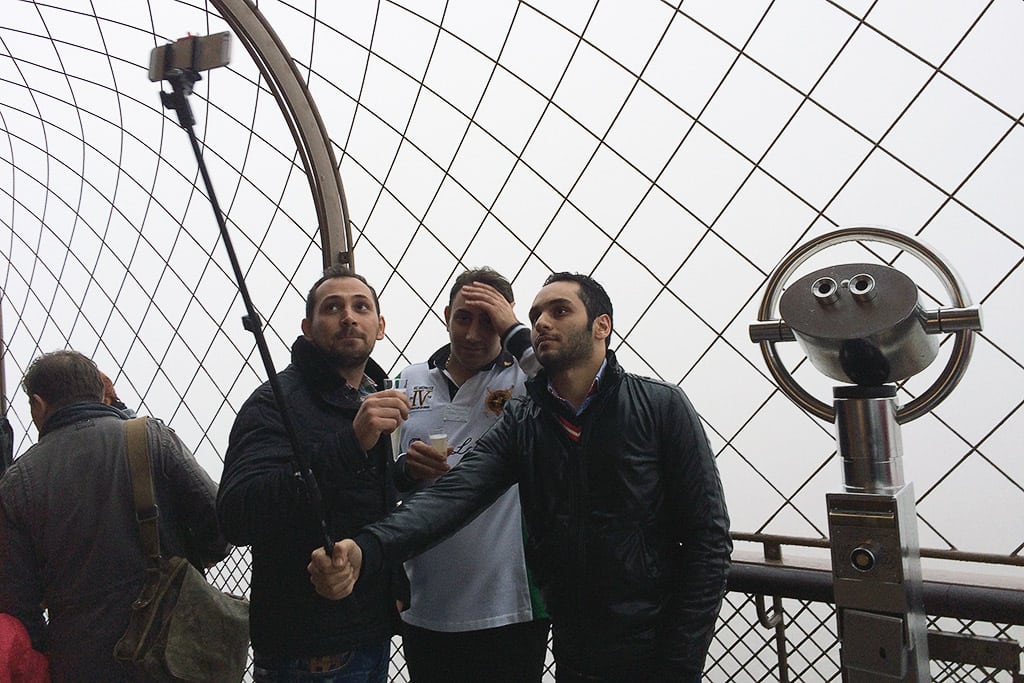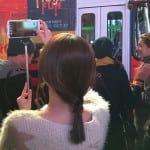Skift Take
The selfie stick will be here to stay in one form or another, even if naysayers don't believe so. With travelers wanting to be cautious about who they hand their phone to in some countries, this product is a huge safety net many are willing to pay for.
- A couple at Gulfoss, the giant waterfall in Iceland, using a selfie stick.
- A couple in Pisa, Italy uses a selfie stick.
- Three friends take a picture with a selfie stick atop the Eiffel Tower in Paris.
- A woman uses a selfie stick to take a picture in Times Square in New York City.
Anyone with a smartphone camera is likely guilty of self-infatuation these days, and one of the more interesting products contributing to this craze is the tourist’s selfie stick.
Selfies aren’t exactly unique to the twenty-first century, given anyone who had a camera and mirror in the past could easily take self portraits, with some of these even dating back to the 1800s.
The selfie that some people take on a daily basis came into being during the past decade, starting with the advent of the MySpace profile picture. The trend gained more devotees when Apple’s iPhone 4 introduced the front-facing camera in 2010. Also that year, Facebook launched Instagram to offer a platform exclusively for photos and video. The network’s choice of filters made it fun to share photos faster and more widely, often with more artistry, than a postcard and stamp could be shared.
With travelers, the desire to show themselves in a place, as a demonstration they were actually there, has only grown stronger with the selfie during the past five years. However, as smartphones became more frequently used than cameras to snap a shot, travelers weren’t as willing to hand off one of their most valuable possessions to a stranger like they’d done for decades before with film and digital cameras.
Knowing this, the trouble with the selfie is that human arms aren’t long enough to get a great shot all the time. Enter the selfie stick, which has caught on with tourists quickly since appearing on the market early this year.
Promaster, which sells selfie sticks, first debuted its product in February, so far selling more than 6,000 units, which Rich Bright, the company’s director of sales, said is “definitely more than was expected” by this point. Bright adds his company was “one of the first in the game for selfie sticks, but I don’t know who invented it.”
“Our initial shipment was expected to last eight months, and we sold through that in three months,” said Bright. “It seems to be picking up now as we move into the holiday season. November was a very strong month, and we expect December to be strong as well.”
“The selfie stick was one of those products that I thought would be popular for a while then start to fade, but so far that’s not the case. We’ve accelerated shipping, and we’re able to ship them but we’re always close to running out.”
Trend or Flash in the Pan?
Like any hot item, there’s always the question of how lasting it will be. Bright thinks there will always be a market for it, but other sellers disagree.
“[The selfie stick] is popular now, but I kind of feel like it will die out next year. It’s a fad and the market will be flooded with them,” said Steven Wong, president of MiniSuit, another seller. “I think it will be really slow and people will only purchase when they decide to travel. On average, products have a six-month shelf life, especially in the tech sector.”
“Initially it was mostly younger people using them, then older people caught on,” said Bright. “As people think about the travel photos they want, the selfie stick becomes the tool they need to take photos of large groups or landscapes. Retailers are now actively selling our devices, and TIME magazine naming it one of the best inventions was really a huge turning point too.”
Promaster’s product stands out among competitors for its ability to adjust to any size phone, Bright said. MiniSuit’s product is unique for its button on the product itself which allows the user to take a photo without having to touch their phone.
“So many people are now being introduced to photography through their smartphones and then upgrade to a more quality camera,” said Bright.
International Trends
Bright says his product is sold in the U.S., Canada, and Australia, and only in specialty stores. BestBuy and Walmart, for example, don’t have access to Promaster’s product as it’s not part of the company’s business model.
MiniSuit is the exact opposite, selling mainly at Walmart and on ecommerce sites primary in the U.S., U.K., and Japan markets. Japan is a newer market for the company in general, and the decision to expand there correlates to the fact that they can make more profits there. In the U.S., Wong said his product typically costs around $20, but runs the gamut of roughly $25 in Japan, yielding a 20% to 30% profit margin.
“I recently traveled to Southeast Asia and everyone is selling [selfie sticks] there,” said Wong. “It’s kind of everywhere right now, the market’s pretty saturated at this point. South Korea recently passed a law that will fine people for using a selfie stick. But that’s leading to a surge in popularity for the product there.”
Asia and South America aren’t aggressive focuses for either company, even as mobile dominates the flow of information and tech on both continents. Wong cites the language barrier as the biggest challenge, but his company is “looking into solutions.” The company may also bring the product to France and Germany in 2015, though plans aren’t finalized.
The Daily Newsletter
Our daily coverage of the global travel industry. Written by editors and analysts from across Skift’s brands.
Have a confidential tip for Skift? Get in touch
Tags: selfie sticks
Photo credit: Three friends use a selfie stick atop the Eiffel Tower in Paris, France. Skift




